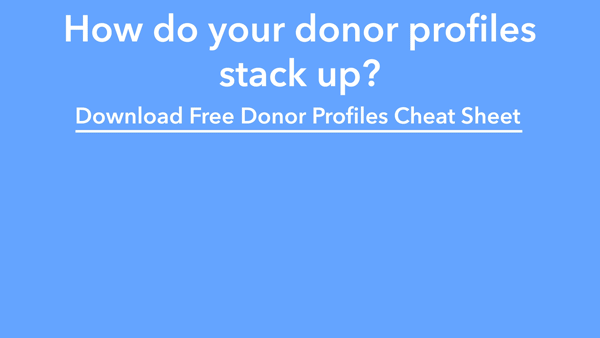How to Build Donor Profiles

The success of your nonprofit organization depends on the generosity of donors. They are your most important assets. How much do you know about these people, both as individuals and as groups?
Creating a donor database and building profiles help you personalize your outreach, deepening the relationships you need to retain and growing donors and their giving. Donor databases capture all meaningful information about donors and the relationships you have with them, and are necessary for creating donor profiles. Once you have your donor database set up, here are some guidelines for building the profiles.
Get to know your donors
The only way you can build donor profiles is by gathering information about your supporters, and the more you know about them, the more you’ll know how to influence them. This data breaks down into three main categories: Basic Info, Networks, and Giving Capacity.
1. Basic Info
Building donor profiles starts with having basic information about them. You already likely have this in a database. It includes their name, email, physical address, contact information, employer, and any other identifying details you collect that help you group donors for profiling.
- Can you generate a report showing how much and how often your donors give? Their past involvement is an indicator of future giving. It’s a key donor profile characteristic to track.
- Do you know if a donor has given to other nonprofits? This is an indicator that they have a pattern of donating.
- What kinds of awards or recognition have your donors received? These tell you about areas of achievement. The information enriches donor profiles. It can help you find specific ways to connect with groups of donors.
- Can you identify their education? Alumni associations, fraternities, sororities, and other affiliations can help you further identify and connect with your donors.
- Do you know the last time your organization made contact with a donor? Adding this information to a donor profile can be helpful.
2. Networks
As you build donor profiles, you’ll find patterns in their relationships. When you find ways to insert yourself deeper into these relationships, you further connect with donor networking.
- Do you know if your donors have children? How about their ages? Parents, in particular, want to donate to make a difference in their children’s lives. Building this information into donor profiles helps you craft messages that resonate and inspire giving.
- Do you know if donors have involvement with a nonprofit that goes beyond just donations? Your supporters who fall into this group are obviously committed to philanthropy. Even if it’s not your organization, you know that they are already interested in community support. Adding this information to their donor profile helps you select specific groups that already have a higher propensity to give.
- Are any of your donors board members of a foundation? Knowing this gives you the opportunity to approach them to help with relationships with other fundraisers. Unlike other donors, they’re already educated about the need for successful fundraising.
3. Giving Capacity
Don’t misconstrue this part of donor profiling; it’s not all about finding rich people. Some of your donors may have annual incomes barely above the poverty line. Building this portion of a donor profile is all about understanding how much they can give.
But let’s say as you look for information in this area, you come across donors who really are wealthy. In that case, if you want to know whether they can make a major gift to your organization, you can determine this by looking at wealth markers by conducting some prospect research.
- Do your donors own stocks?
- Have they invested in real estate?
- What did your wealthy patron donate last year?
Knowing the answers to questions like these will help you understand donor-giving capacity. The information is freely available from the Securities and Exchange Commission (SEC).
The more you know
If you’re new to donor profiles, be sure to read our introduction to donor profiles to make sure you collect the right information that will help you raise more money, Collecting this information might seem as if you’re intruding on the private lives of people. It’s important to remember that the data you collect will be used to find ways to make it more inviting and more comfortable for people to give.
The tool to build donor profiles
It’s possible to build donor profiles with spreadsheets and word-processing documents, but that’s like digging a trench with a teaspoon; there’s just too much data coming in about your donors! Building donor databases is becoming an increasingly important move for nonprofits looking to successfully engage with their constituents, who are also more likely to be generous with the information you desire when they can share it with you online.


